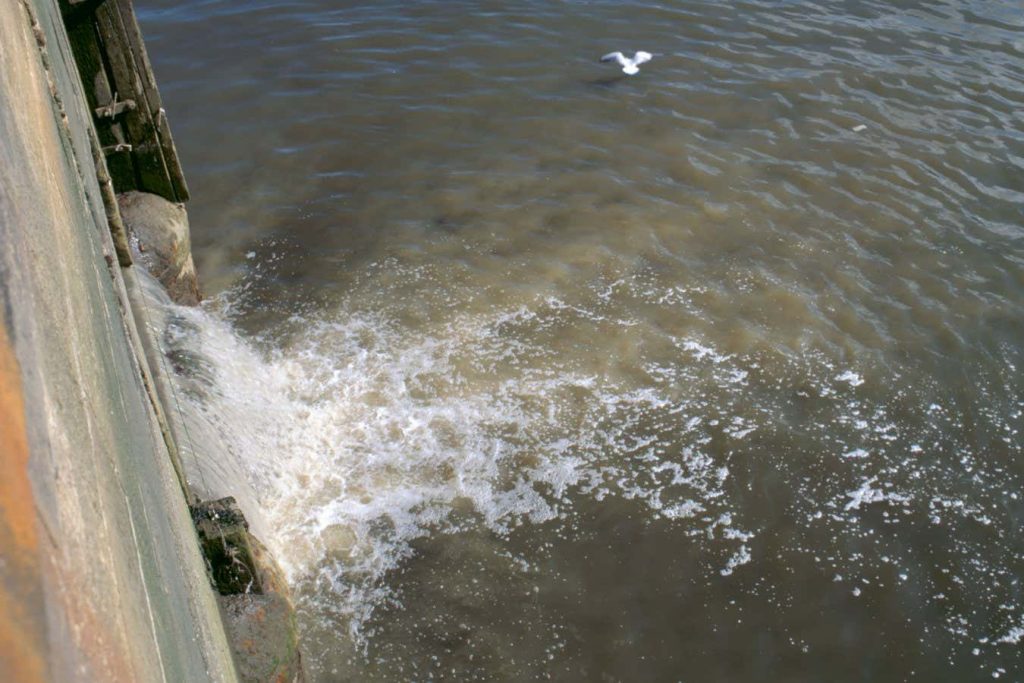Sewage discharging into the river Tyne in Newcastle upon Tyne, UK
Leslie Garland Pictures/Alamy
Untreated sewage can account for about three-quarters of the bacteria found in a UK river during a rainstorm, despite claims from some water companies that storm discharges have minimal effect on water quality.
Water firms in England are permitted to discharge raw sewage into rivers and seas during unusually high rainfall, when there is a risk that the system may be overwhelmed and effluent could back up into people’s homes. In 2022, raw sewage was released into English rivers and seas 825 times a day on average.
Raw sewage contains a high concentration of bacteria such as E. coli and intestinal enterococci, which can cause diarrhoea. But until now, no studies had directly linked river bacteria levels to raw sewage discharges. In England, bacteria levels are only regularly monitored on three stretches of river, which have been designated as official bathing sites.
Advertisement
To investigate what impact sewage overflows have on river bacteria, David Werner at Newcastle University, UK, and his colleagues took several water samples from the river Ouseburn in Newcastle upon Tyne in 2021.
Werner and his team collected one set of samples during a period of dry weather, another set during a rainstorm and another set 24 hours after a bout of heavy rain. They also collected a sample from a sewage overflow as it discharged into the river.
The researchers then analysed the DNA found in all the samples. By comparing the composition of bacteria in the river samples with the sewage samples, they could estimate what percentage of bacteria found in the river was due to sewage release. “It can help us distinguish between bacteria found in human guts compared to animal guts,” says Werner.
They found that during a rainstorm, when sewage is actively being released into the river, between 72 and 77 per cent of the bacteria downstream of the discharge comes from the sewage. “It surprised me how high this figure was,” says Werner.
The researchers saw that sewage-related bacteria levels fell 24 hours after rainfall, but Werner says these levels are still too high to be considered safe for humans. “If you have a lot of discharges, this legacy is kind of building up over time,” he says.
The team also collected 16 separate samples on another stretch of the same river in a local park, where people regularly swim. Analysis of these samples confirmed that bacteria levels rose dramatically during rainfall and then returned to more typical levels soon afterwards.
The amount of intestinal enterococci found in the river exceeded safe levels for human health by between seven and 611 times. E. coli levels reached around 33 times higher than those required to achieve bathing status.
Some water companies have claimed that the impact of storm discharges on river water is likely to be minimal because they are heavily diluted by rainwater. But the team estimated that the discharge released during a sewage overflow is likely to be about 5 per cent raw sewage.
“That might sound like a small amount, but the way I think about it is if you have a cup of tea which is about 100 millilitres, 5 per cent is a teaspoon of sewage – you wouldn’t drink from it would you?” says Werner. “And because sewage is so highly concentrated in faecal bacteria, a lot of that ends up in the river.”
While this study only looked at one river, Werner says it is likely to be representative of small rivers found throughout urban areas in England, which have less water to dilute contaminants than larger ones.
Data like this can help people make informed decisions about whether to go wild swimming, says Sean Tyrrel at Cranfield University, UK.
“It’s also important to think about the discharges of treated sewage that happen 24/7, not just storm flows,” he says. “Long spells of dry weather mean lower dilution of the treated sewage discharges and may be the times when the public are more likely to come into contact with river water, so a big-picture, risk-based approach is a good thing.”
A spokesperson for Northumbrian Water, which manages wastewater in Newcastle, said in a statement: “The results from this latest study provide a really helpful insight for us. It’s an area that hasn’t been looked at before, and we’re keen to work with partners like the university as we work towards reducing the frequency and impact that our operations have upon the environment.”
A spokesperson for Water UK, which represents the industry as a whole, said in a statement: “Every water company is firmly of the view that urgent action is needed to tackle the harm to rivers caused by sewage overflows. Water companies plan to spend £10 billion over the next seven years in an intensive programme to improve sewage overflows – tripling current levels of investment – as part of the biggest modernisation of sewers since the Victorian era.”
Topics:

